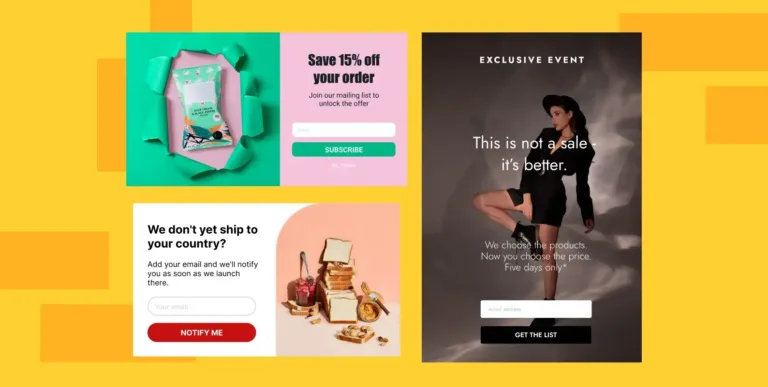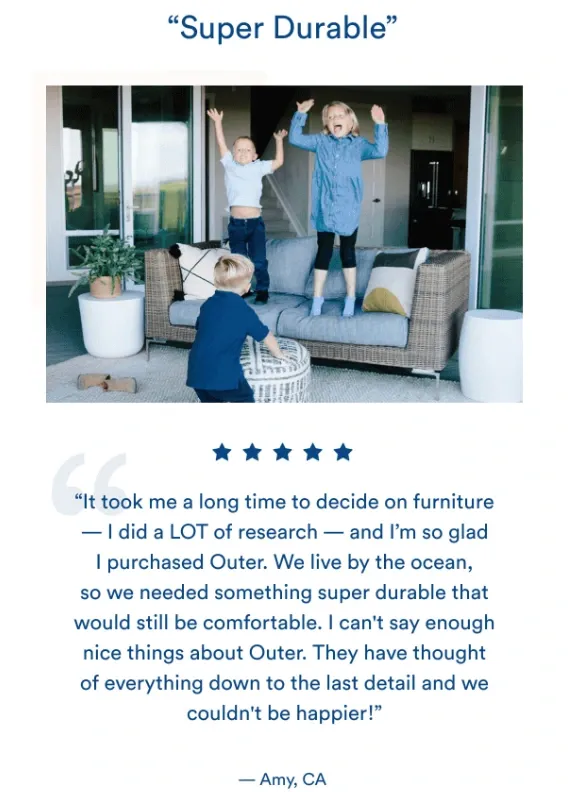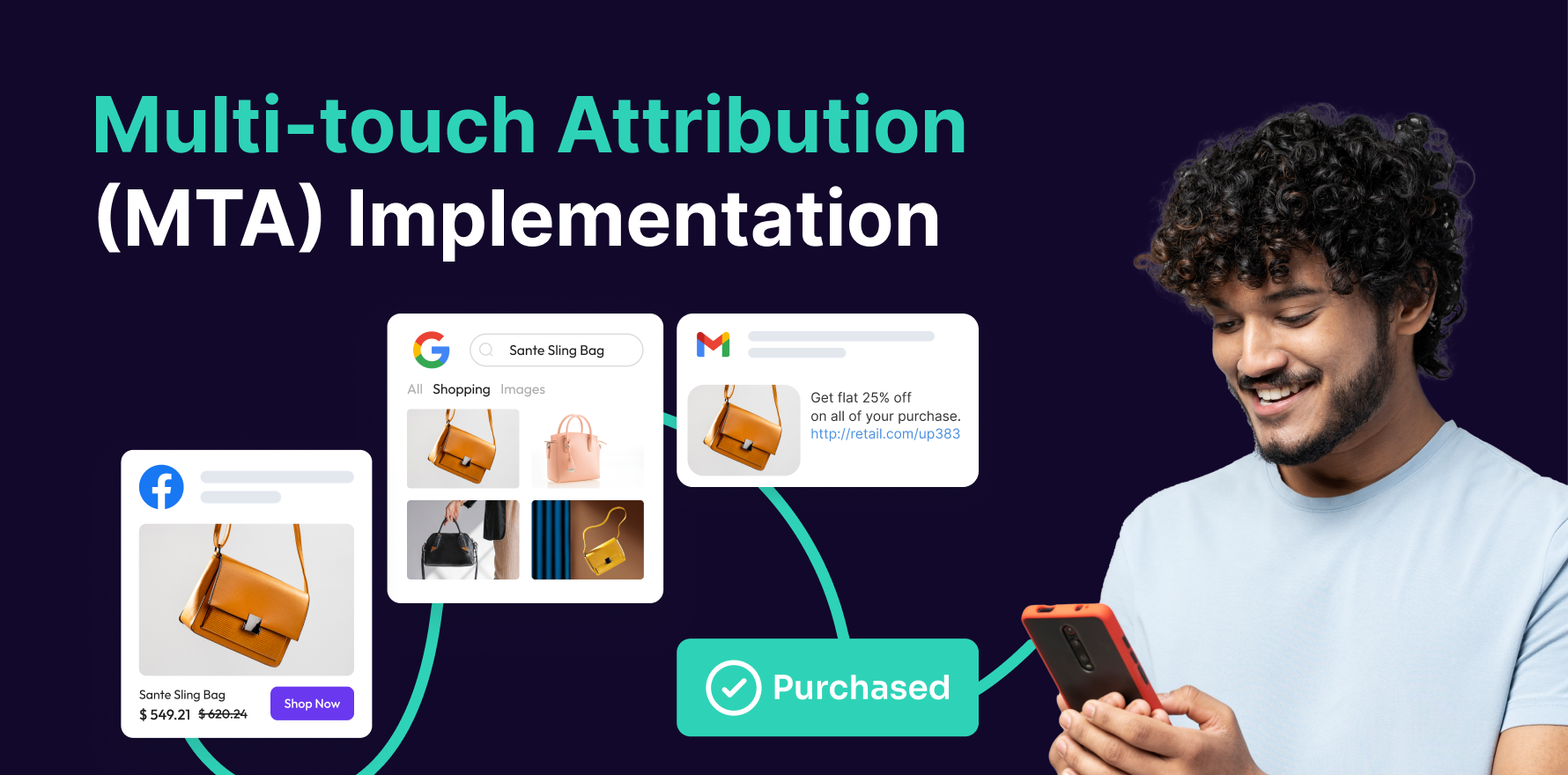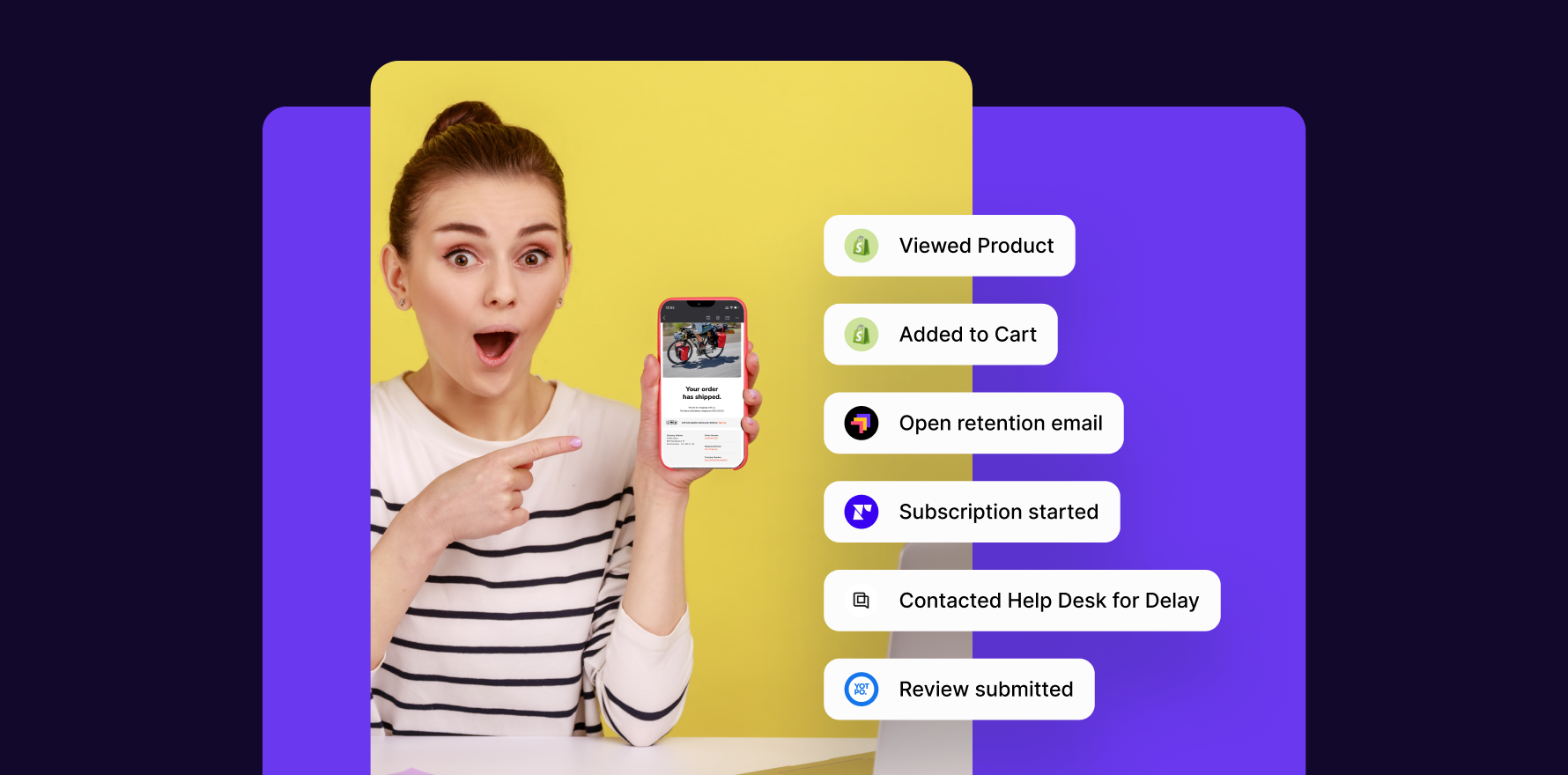Emails had a humble beginning in 1971, but it has come a long way since. Today emails are an integral part of our personal and professional lives. By 2025 the projected number of email users globally will be a staggering 4.60 billion which is why emails are one of the most powerful communication channels for any brand to keep its customers engaged.
In the fast-paced world of ecommerce though convenience rules from shoppers’ standpoint, the brand has a huge challenge to deal with. Ecommerce stores lack the ability to provide personalized service that physical retail stores do. This is where email marketing comes into play. As David Newman says:
“Email has an ability many channels don’t: creating valuable, personal touches – at scale.”
Email marketing when done right is one of the most powerful and cost-effective tools for businesses to engage with customers, have personalized interactions, gain meaningful insights, and drive sales. However, to fully capitalize on its benefits, businesses need to stay updated on the latest strategies and best practices that can drive campaign success.
In this blog post, we will explore 15 email marketing strategies that are essential for achieving campaign success. From list building and personalization to mobile optimization and GDPR compliance, these strategies are designed to help you navigate the ever-evolving ecommerce landscape and maximize the impact of your email marketing efforts. So, let’s get started!
Best email marketing strategies for campaign success
To make a strong building one needs to put a strong foundation. The same applies to every aspect of life. A lot goes behind making any marketing campaign a success. One needs to get the basics right for any marketing campaign to be a success. Here are our top 15 strategies to make your email marketing campaign a success. Let’s dive in!
1) Build a quality email list
A successful email marketing campaign starts with building a quality email list, ensuring you reach the right audience with your message. Therefore, it’s essential to analyze your email list at regular intervals. Track how many people on your email list are engaging with your brand. If the number of subscribers not engaging is significantly high consider sending re-engagement emails to rekindle the connection. It is a good practice to purge your email list from time to time to remove any duplicate or spam IDs and get rid of contacts who are no more interested in engaging with your brand.
Like Corey Dilley, marketing manager at Unbounce says – “Unbounce’s email list is the biggest asset we have for driving new acquisitions.”
Unbounce gets a whopping 80-90% of its landing page traffic from email marketing. Need we say more about the power of email marketing and a good quality email list?
2) Segmentation and personalization
A research report suggests that relevant emails drive 18x more revenue. But how do you make sure to send emails that are relevant and appeal to your audience?
Well, the secret lies in segmenting your target audience into specific groups and sending content that resonates with them. Effective email campaigns utilize segmentation and personalization to target specific customer groups and deliver relevant content. There are many ways in which you can segment your email list such as
- Purchases made in the past
- Past browsing behavior
- Email update preferences
- Demographics – Age, gender, and location
Segmenting your email list has a plethora of benefits and helps you maintain a healthy mailing list. Some of the advantages of segmentation include
- Increased email open rates
- Increased click-through rates
- Higher conversions
- Minimal subscriber churn
- Mitigates spam filters
3) Mobile-friendly email design
Are you still designing emails that are only web/desktop friendly? Reports suggest that 4 out of 10 emails are opened on mobile phones. That’s leaving out a huge audience. In today’s smartphone age where people are glued to their phones, it’s important to design emails that are mobile-friendly too.
We all know that when it comes to fashion, it’s all about the aesthetics. Eye-catching imagery is key to selling products, and ASOS knows this better than anyone else.
However, creating stunning visuals can present a potential email marketing challenge. By dedicating so much space in an email to a hero image, there is less room for copy. And let’s face it, a well-crafted copy can make all the difference between someone clicking through and making a purchase, or simply scrolling past and forgetting all about it.
So, how does ASOS tackle this challenge?
Well, they have a clever solution that you might not have noticed before. Take a look at their desktop version compared to the mobile version.
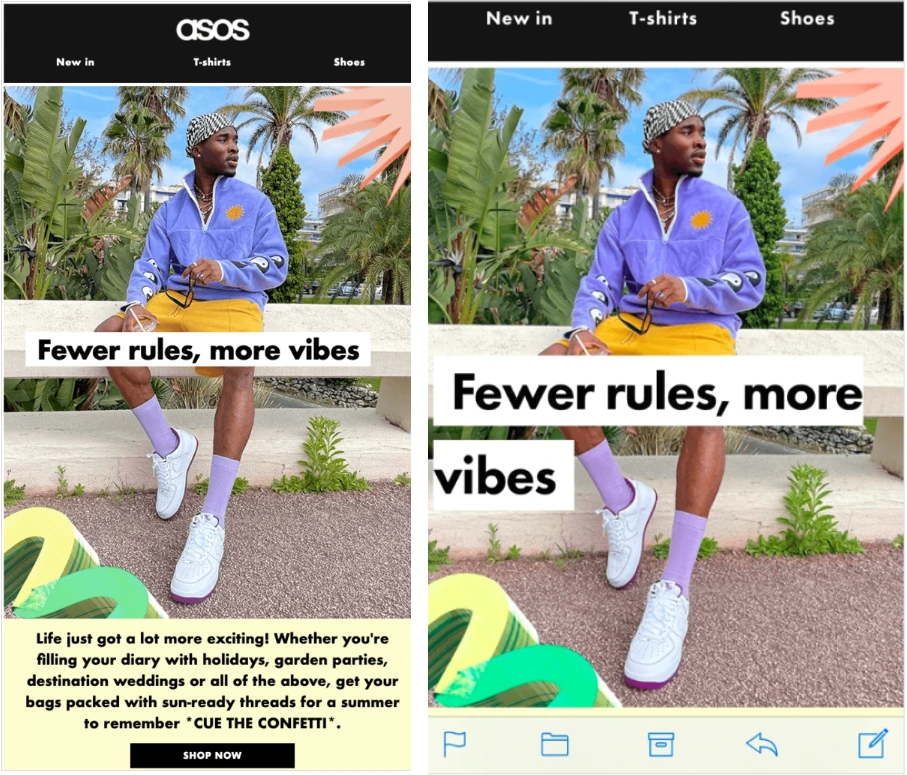
In the mobile version, you’ll notice that the copy is much larger in proportion to the hero image. This makes the email much more accessible for mobile users, without requiring them to squint to read the text on a smaller display.
ASOS also uses a simple yet effective technique of using black text against a white background, ensuring that the copy is easily readable regardless of where the responsive email design positions it on the screen. This is particularly important because the hero image usually contains a lot of colors, and black text might not stand out so well against all of them.
By using these winning email marketing strategies, ASOS ensures that its emails are not only visually stunning but also highly effective in driving sales.
4) Craft compelling subject lines
People send and receive an average of 121 emails on any given day. Your email really needs to stand out in the crowd and what better way than writing a subject line that generates curiosity, grabs attention, and is highly engaging? 33% of email recipients open emails solely on the basis of an email’s subject line.
Crafting a subject line that makes an impact is crucial to the success of your email marketing campaign. Oscar an email marketing expert for ecommerce DTC brands shares 7 tips to create impactful subject lines:
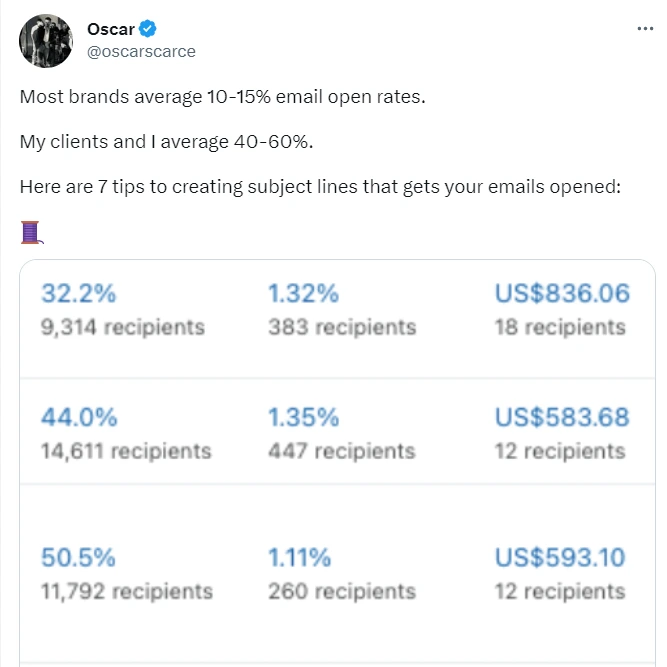
Personalization is key to showing your subscribers that you have a relationship with them. So, using their name or mentioning previous purchases or behavior is a great way to make your subject line more personal and relevant to them.
Questions are another effective technique that can create an unanswered loop and pique your readers’ curiosity or FOMO (fear of missing out). For example, “Have you heard about…”, “Are you making this mistake?”, or “What to do when (problem) happens”. These types of subject lines can encourage readers to open your email to find out the answer.
Keeping it short and sweet is important too, as it helps to focus on the most important message. Using 6-10 words and keeping it under 50 characters can make your subject line easy to read and understand, and help it stand out in a crowded inbox.
Numbers or statistics can also be an effective way to simplify a process or cut through the noise. For example, “7 ways to…” or “4 steps to…” can make your subject line more specific and actionable.
Sometimes, being surprising or nonsensical can work too, especially when it comes to offbeat but valuable information. For example, “Did someone say pizza?” or “5 ways to use pineapple” can grab your reader’s attention and make them want to know more.
Finally, communicating urgency can be effective in creating a sense of FOMO and encouraging readers to take action. For example, “Last chance to buy”, “Flash sale ends tonight”, or “One seat left”. However, use urgency sparingly and only when it’s truly appropriate, as people can quickly become desensitized to these types of subject lines.
5) A/B testing
A/B testing is essentially designing two email campaigns (different subject lines/imagery/subject/design) – campaign A and campaign B and sending it out to a small set of your target audience. A is sent to one set of audience and B to another set of audience. The set that has a higher open and CTR rate is then sent out to the target audience.
A/B testing is an essential strategy to optimize your email marketing campaigns and enables a brand to make data-driven decisions. A/B testing is not a one-time activity but a continuous activity that ensures that your email marketing initiatives stay on point and deliver the desired outcomes.
Continue reading: How To Ace A/B Testing In Ecommerce? Strategies, Examples & Tools
6) Automating email campaigns with triggers
Automated email campaigns are typically a trigger in response to a specific customer behavior or action which means it is personalized. Customers tend to shop from brands that deliver highly personalized experiences and automated trigger emails help you do just that.
In fact, automated emails generate 320% more revenue in comparison to manual campaigns. Besides, email automation ensures that relevant information is sent to the customer on time and your team can utilize the time saved on more important tasks. We had to say a win-win for all parties involved.
Here’s an example of a browse abandoned email from a footwear brand, Kizik.
Subject: Did you see the newest colorways?
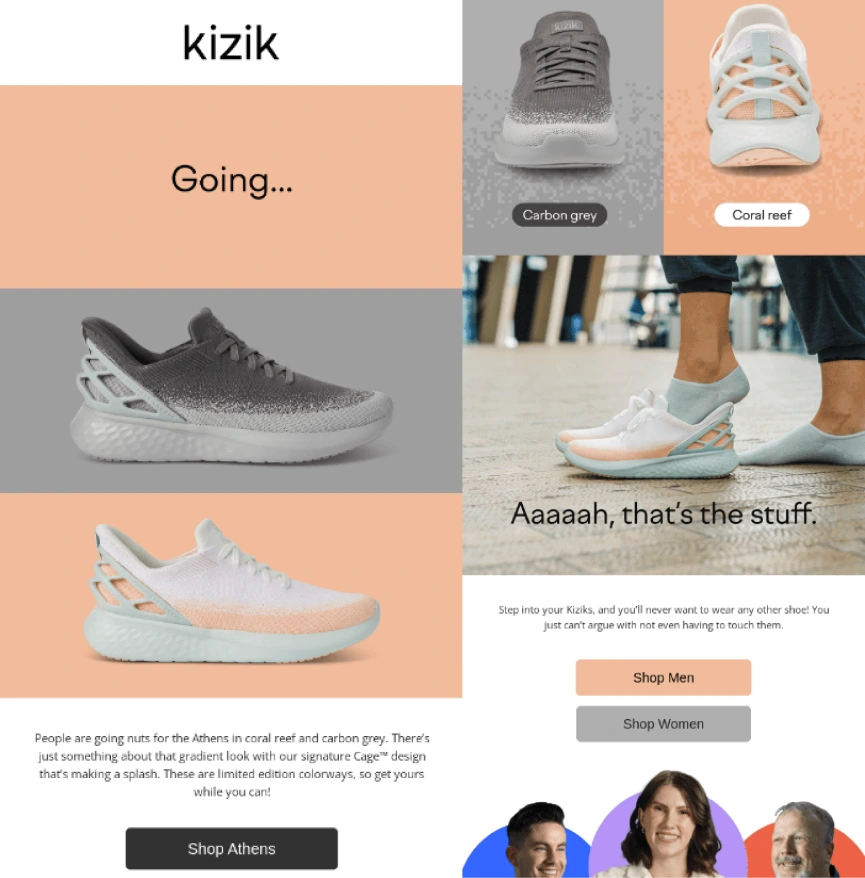
Continue reading: 5 Automated Emails Your DTC Brand Should Send
7) Re-engagement and win-back campaigns
It is no secret that retaining old customers is not only easier, but it is also a more cost-effective option than acquiring new customers. Acquiring a new customer entails 7x more expensive than retaining a new one. Besides, old customers tend to buy more from a brand and also recommend the brand to friends and family.
This is reason enough to design email campaigns to re-engage inactive subscribers and win back lost customers with targeted email campaigns and make your marketing campaigns a huge success.
Here’s an example of a re-engagement email from a California-based beauty brand, Wonder Valley.
Subject: We’re Gifting Mini Face Oils with Orders $25+
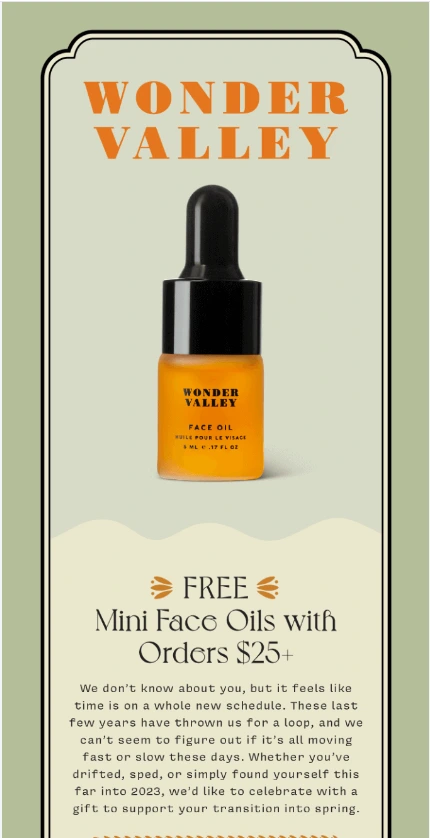
8) Incorporating storytelling
We live in a world where people are hyper-active in the digital space and consume large volumes of content. An average person receives tons of ad notifications and promotional emails daily, making it difficult for brands to stand out and be seen.
Incorporating the Storytelling approach actually humanizes a brand and creates an emotional connection with its customers. And you know what that means? It means the brand becomes more relatable and likable.
Beauty blogger Huda Kattan started the famous make-up beauty brand HUDA BEAUTY in 2013.
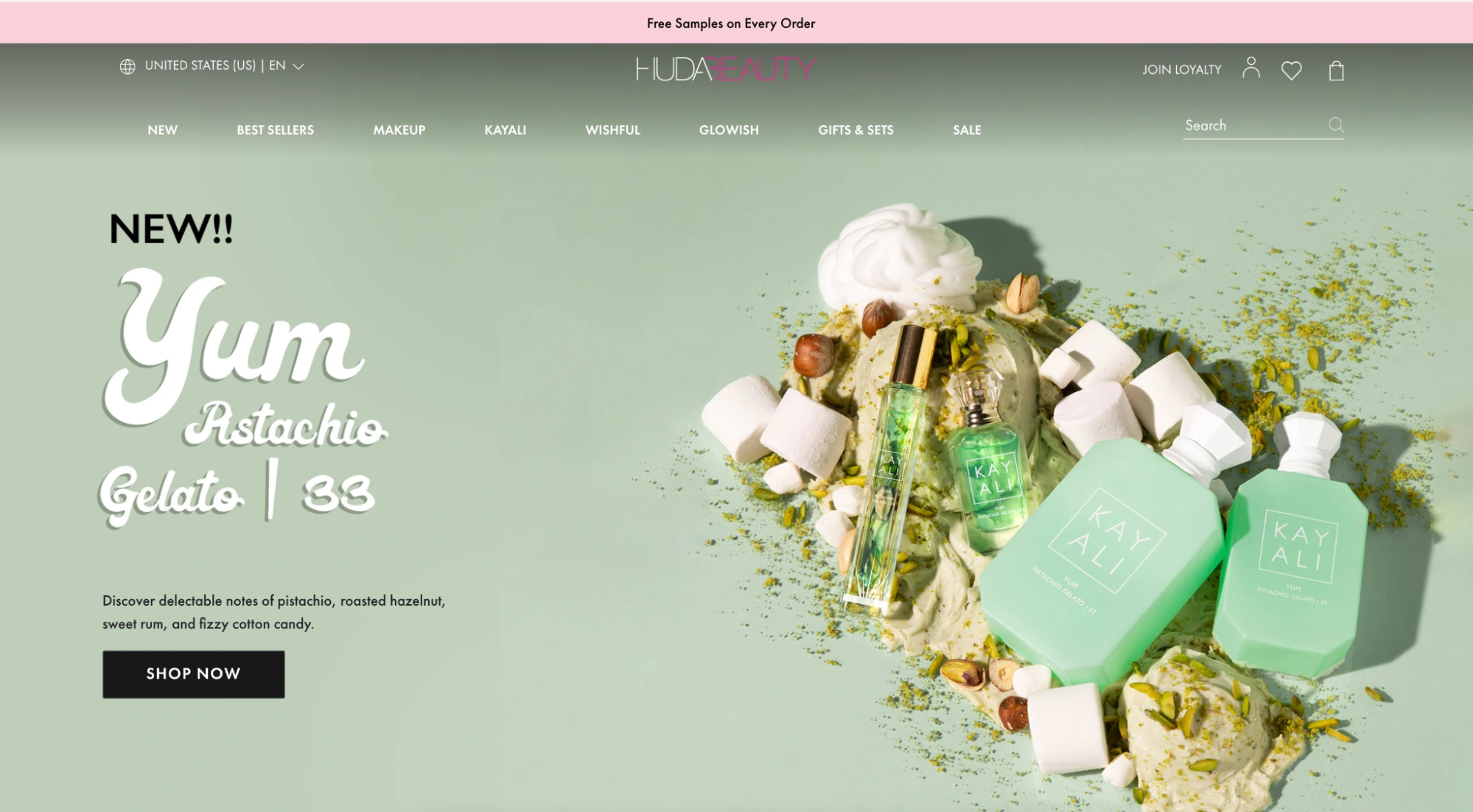
Part of the brand’s success can be attributed to the fact that most beauty video tutorials Huda uploads include behind-the-scenes everyday snippets of her life and how her daughter is using make-up. Huda Beauty very smartly incorporated storytelling and the customers felt connected personally to Huda. They trust her deeply and the brand comes across as human as Huda herself is the brand.
9) Utilizing user-generated content (UGC)
Any non-sponsored content that an end-consumer creates for a brand is referred to as user-generated content or UGC. A review on Google, a product review on an ecommerce website, and a post on Instagram about a product are all examples of UGC. While most brands use UGC in social media and other online promotions, it is a great strategy to use in email marketing too.
People perceive UGC as more authentic compared to content created by a brand, celebrity, or influencer. Today 99.9% of customers read reviews before making a purchase online and a staggering 49% of customers trust an online review as much as they would trust a recommendation made by their friends and family.
Here is an example from the outdoor furniture brand Outer. They send out emails with this review attached.
Use of UGC by the outdoor furniture brand Outer
So next time you plan an email marketing campaign to win back disengaged customers or send a trigger email to someone who abandoned their shopping cart make sure to include UCG in your email. Leverage user-generated content in your email campaigns to build trust, authenticity, and a sense of community among your customers.
10) Integrating social media and email marketing
Both social media and email marketing are key elements of any digital marketing strategy. The United States has 302.35 million active social media users as of date and this number is expected to reach 331.09 million by 2028.
That’s a sizable portion of people to be reached out to. Consider integrating your social media with your email marketing campaign to reach out to a larger audience base. There are many ways in which you can integrate social media and email marketing, such as:
- Adding CTAs in your email copy to lead the recipient to your social media handle.
- Leverage social media to build your email subscription list.
- Use QR codes in your emails to direct a person to social media or a post regarding your latest product launch.
- Let your social media posts and emails send out the same message, think about aligning your email and social media content.
11) Leveraging artificial intelligence (AI)
AI is all the rage these days and for good reason, it helps increase revenue and decrease costs. There are a number of ways in which you can utilize AI to reduce the manual and repetitive tasks of your email marketing campaigns and make them much more effective. A few areas where AI can help when it comes to email marketing campaigns are:
- Drafting an engaging email copy and subject lines
- Optimize email send time
- Clean email list
- Restructure your campaign using historical data
- Send automated trigger emails
By harnessing the power of artificial intelligence (AI) and machine learning email marketers can completely transform the way email marketing campaigns are executed. A lot of manual and repetitive tasks can be done away with which in turn will help optimize email marketing campaigns, enabling data-driven insights, personalization, and predictive analytics.
Continue reading: 8 Ecommerce Problems That Artificial Intelligence Can Solve
12) Gamification in emails
Gamification is generating a lot of interest among digital marketers as it helps engage customers better, helps them feel more involved and is a great way for brands to directly interact with customers. The use of interactive elements in an email persuading customers to complete a task is referred to as gamification. When designing email campaigns consider adding interactive elements such as quizzes, polls, or videos, into your email campaigns, encouraging subscribers to interact directly with your message.
Gamification is a great way to
- Enhance subscriber engagement
- A majority of millennials and Gen-Z comprise the population with buying power and they feel more involved when interacting with a brand
- Great way to create hype before a new product launch
- It is a great way to create UGC
- It helps you immediately grab attention
A great way to introduce gamification in emails in the form of a crossword puzzle here.
13) Offering exclusive deals and promotions
An additional discount, a free voucher, or a special promo code never hurt anyone. Emails containing special offers, early access passes to a mega sale event, or a coupon code on special occasions are sure to grab eyeballs. What are you thinking, boost customer engagement and drive sales by offering exclusive deals and promotions in your email campaigns.
14) Measuring campaign success
You launched an email campaign, but how do you know whether it is working or not? This is where tracking metrics like open rates, and CTR rates become important. Email marketing metrics are data points that help email marketers determine how your emails are performing and how recipients are engaging with your emails.
By tracking these metrics you get insights on what is working and what is not. It helps you see what changes are required to your email marketing strategy to get desired results. Keep track of your email campaign performance with key metrics to assess success and identify areas for improvement.
Continue reading: Email Marketing Metrics Every Ecommerce Brand Should Track
15) GDPR compliance and respecting privacy
General Data Protection Regulation (GDPR) came into effect in 2019. As per this regulation, a company needs to take consent from the user to be included in any of its marketing campaigns and the brand must guarantee to protect a user’s personal data and not disseminate it to third parties.
Ensure your email marketing strategies adhere to GDPR guidelines and respect your subscribers’ privacy, maintaining trust and credibility. The consent to subscribe to your emails must be given by people of their own free will, refrain from making it compulsory for a user to subscribe to campaigns in order to make a purchase or download the latest issue of your e-magazine.
Conclusion
We live in a digitally connected world and the ecommerce D2C space is evolving at an unprecedented pace. Marketers need to keep up with the latest technologies, think out-of-the-box, and reinvent the marketing wheel to stay relevant and ahead of the curve to engage their customers effectively. Email marketing remains a time-tested and powerful tool for targeted communication that can drive customer loyalty, conversions, and growth.
As renowned marketing expert Seth Godin once said, “The only way to consistently grow in B2B (or B2C) is to be better than very good.”
By embracing these email marketing strategies and committing to continuous improvement, new-age marketing gurus will not only meet but exceed the expectations of their customers, fostering long-term relationships and driving sustainable growth for the business. It’s time to elevate your email marketing game and propel your ecommerce success to new heights in 2023 and beyond.
You may also like
Essential resources for your success
